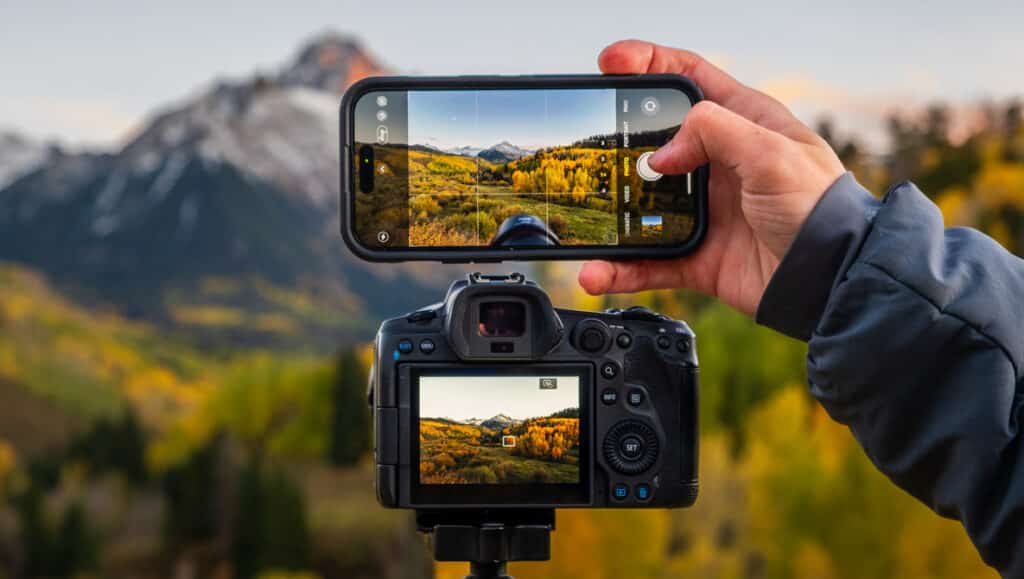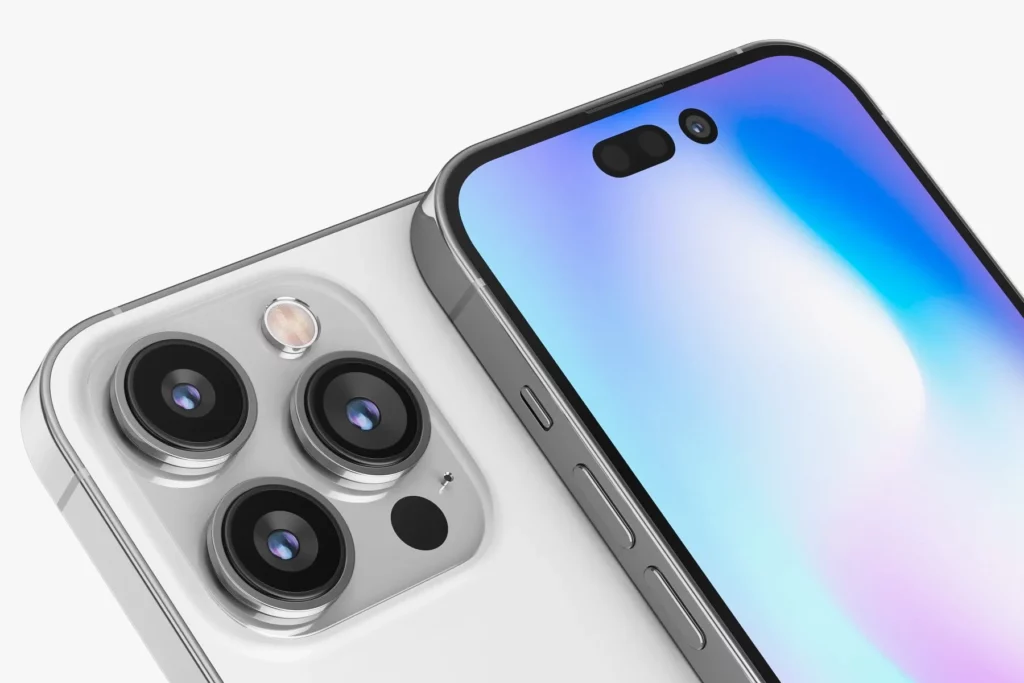The battle between smartphones and DSLRs has been a captivating spectacle in photography. With the release of the iPhone 14 Pro and Pro Max, the “iPhone 14 vs DSLR” has been a topic of hot debate.
Apple’s latest offering brings a host of advanced camera and video capabilities, rivaling those of high-end DSLRs.
This article delves into a side-by-side comparison of the iPhone 14 Pro and Pro Max with traditional DSLRs, analyzing their strengths and weaknesses. If you’re a photo enthusiast grappling with the “iPhone vs. DSLR” problem, this comprehensive guide is a must-read.

Related: Can a DSLR Record Video?
Comparing the Camera Capabilities of a DSLR and the iPhone 14 Pro and Pro Max
Sensor Size
The sensor size plays a crucial role in image quality and detail, and here’s where DSLRs typically outshine smartphones. Most DSLRs come equipped with either an APS-C-sized or a full-frame sensor, significantly larger than the iPhone 14 Pro and Pro Max sensors. A larger sensor means more light collection capacity, improving image quality, especially in low-light conditions.
However, Apple has made impressive strides in its sensor technology. The iPhone 14 Pro and Pro Max boast a 1.7 µm pixel size, the largest ever in an iPhone. It allows for more light intake per pixel, significantly improving low-light performance and details.
Lens Options

A DSLR camera traditionally holds the advantage when it comes to lens versatility. With a DSLR, photographers have various interchangeable lenses, ranging from wide-angle and telephoto to macro lenses. This versatility allows DSLR users to adapt to any shooting environment or style.
On the other hand, while not supporting interchangeable lenses, the iPhone 14 Pro and Pro Max have a built-in triple-lens system: a wide lens, an ultra-wide lens, and a telephoto lens.
This system provides users with flexibility, enabling them to capture a range of shots, from sweeping landscapes to detailed portraits, without carrying around additional equipment.
Moreover, Apple’s Pro models are equipped with sensor-shift optical image stabilization, typically found in professional-grade DSLRs. This technology helps reduce camera shake, ensuring clearer and more stable images, especially in low light conditions or when using the telephoto lens.
While DSLRs offer greater versatility with a broader range of interchangeable lenses, the iPhone 14 Pro and Pro Max counter, with an integrated versatile lens system and advanced stabilization features, contribute another fascinating element to the “iPhone vs DSLR” conversation.
Video Recording Capabilities
The contest of “iPhone vs DSLR” continues in the realm of video recording, with both the iPhone 14 Pro and Pro Max and DSLRs offering their unique strengths.
Professional DSLRs are renowned for their superior video quality, thanks to their large sensors and interchangeable lenses, which provide excellent depth of field and low-light performance. They also offer the freedom to adjust settings manually, including shutter speed, ISO, and white balance, giving the videographer control over the output.
However, the iPhone 14 Pro and Pro Max are not to be underestimated. These devices come equipped with the new Cinematic mode, which introduces depth-of-field transitions and focuses changes that were once exclusive to professional movie cameras.
This feature allows users to create dramatic depth effects and automatically changes focus when subjects enter the frame or look away.
Image Quality
Regarding image quality, DSLRs have typically been the undisputed champions. The larger sensors of DSLRs, coupled with the ability to use various lenses, offer superior image resolution, depth of field control, and low-light performance. However, the iPhone 14 Pro and Pro Max are closing this gap significantly.
Apple’s latest iPhones utilize computational photography extensively to overcome hardware limitations. This includes techniques such as Deep Fusion and Smart HDR 3 that analyze multiple frames, pixel by pixel, to bring out detailed textures, accurate colors, and reduced image noise.
The iPhones also support ProRAW, which, when combined with the power of Apple’s A15 Bionic chip, provides users with creative control in post-processing, similar to shooting in RAW on a DSLR. This feature allows users to adjust exposure, color, and tone with no image degradation, leading to high-quality final results.
The iPhone 14 Pro Max goes a step further with its bigger sensor, which improves its performance in low-light conditions and minimizes noise, making it a strong competitor to DSLRs regarding image quality.
While DSLRs may offer better control and image quality due to their large sensors and interchangeable lenses, the iPhone 14 Pro and Pro Max make a compelling case with their improved sensors, versatile lens options, and superior portability.
Front and Back Cameras

An exciting aspect of the “iPhone vs DSLR” discussion is the availability of both front and back cameras on the iPhone 14 Pro and Pro Max. With its devoted rear-facing camera, the DSLR excels in capturing professional-grade photographs.
However, it lacks a front-facing camera, a significant downside for those who enjoy taking selfies or need to video conference.
In contrast, the iPhone 14 Pro and Pro Max not only come with a highly capable rear camera system but also a front-facing camera, known as the “TrueDepth camera.” This 12-megapixel camera features Night mode, Deep Fusion, and Smart HDR 3, bringing all the advanced photographic capabilities to your selfies.
Including both front and back cameras in the iPhone 14 Pro and Pro Max significantly enhances their versatility, providing users with additional options and functionalities not typically found in a DSLR. This factor further enriches the debate of “iPhone vs DSLR,”, particularly for users who value the ability to capture high-quality images from both camera orientations.
Convenience and Portability
The iPhone 14 Pro and Pro Max have a clear advantage over DSLRs when discussing convenience and portability. The sheer size and weight of a DSLR, plus additional lenses and accessories, make it less portable and more cumbersome to handle, especially during extended shooting or traveling periods.
On the contrary, the iPhone 14 Pro and Pro Max fit easily into a pocket or small bag, offering high-quality photography capabilities on the go. They simplify capturing, editing, and sharing photos or videos.
With features like Photographic Styles and ProRAW, users can customize their photography experience and directly edit their shots on the device. The Cinematic mode and ProRes video recording bring exceptional video capabilities, previously exclusive to professional cameras, to the palm of your hand.
This aspect of convenience and portability further fuels the “iPhone vs DSLR” debate. For users prioritizing ease-of-use, compactness, and the ability to share their work instantly, the iPhone 14 Pro and Pro Max present a compelling argument.
Affordability
When considering cost, the “iPhone vs DSLR” debate takes on a different dimension. Generally, DSLR cameras can range widely in price, with entry-level models starting relatively low and professional-grade cameras attracting a premium.
These DSLR cameras can range from $1,500 to over $3,000, depending on the model and where you buy them. Remember that this is just the body; lenses can cost anywhere from a few hundred to several thousand dollars each. On the other hand, iPhone 14 Pro and Pro Max start from $999 to $1099, respectively.
It’s also worth considering the total cost of ownership. With an iPhone, updates to the operating system and camera software are included at no extra cost, and the device serves multiple functions beyond photography.
A DSLR, however, may require additional investments in lenses, maintenance, and potentially costly upgrades to keep up with advancing technology.
Conclusion
In conclusion, the “iPhone vs DSLR” debate is complex, and the right choice depends on individual preferences and needs.
A DSLR with its interchangeable lenses and larger sensor might still be the best choice for professional photographers seeking maximum control over their photography.
However, for those who prioritize portability, ease of use, and the ability to shoot and share high-quality photos and videos on the go, the iPhone 14 Pro and Pro Max offer compelling features that challenge their DSLR counterparts. iPhone 14 delivers advanced camera technologies, dual camera orientation, and competitive image quality, all packed into a sleek, lightweight device.
Furthermore, with their reasonable pricing relative to professional-grade DSLRs, these iPhones represent a significant shift in the world of photography, making high-quality imaging more accessible to all.
Frequently Asked Questions
Is iPhone 14 Camera Better than DSLR?
The comparison between the iPhone 14 camera and a DSLR is not entirely straightforward, as each has unique strengths. The better option ultimately depends on the user’s requirements and their intended use.
A DSLR remains the superior choice for professional photographers who value absolute control over their settings and desire the highest possible image quality. The larger sensors and the flexibility of changing lenses give DSLRs the edge in overall image quality, especially in challenging lighting conditions.
On the other hand, the iPhone 14 Pro and Pro Max have made significant strides in camera technology, bringing professional-level features to the smartphone platform. With advanced computational photography features like Deep Fusion and Smart HDR 3, these devices deliver excellent image quality for most common scenarios, often rivaling DSLRs.
In terms of portability, versatility, and the convenience of having a multi-purpose device (phone, internet browser, camera, etc.), the iPhone 14 undeniably outshines the DSLR. The ability to instantly edit and share high-quality photos and videos directly from the device is a game-changer for many users.
So, while the iPhone 14’s cameras may not completely surpass a DSLR in all aspects, they offer an impressive and compelling alternative for users seeking a balance of convenience, functionality, and quality in their photography and videography pursuits.